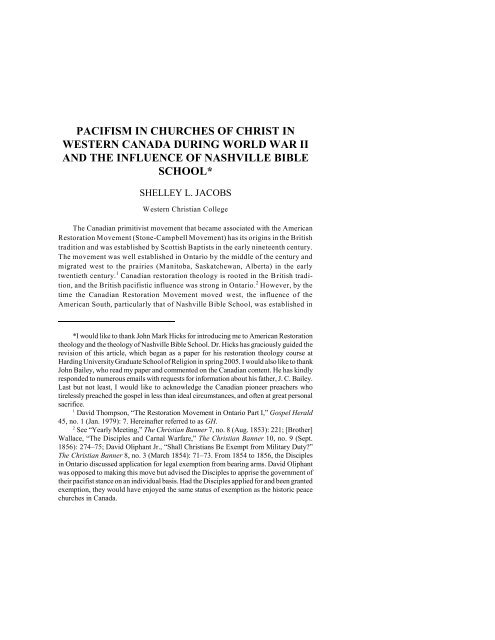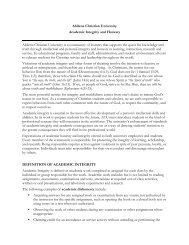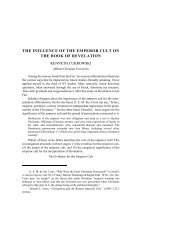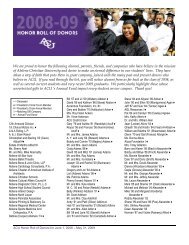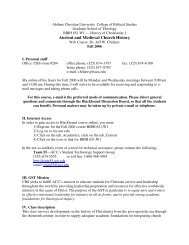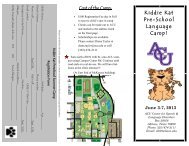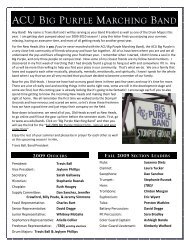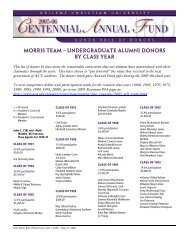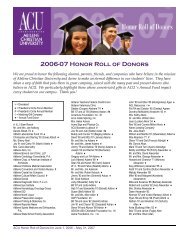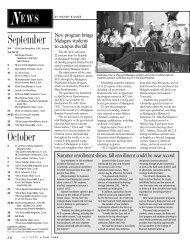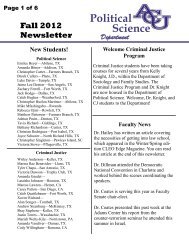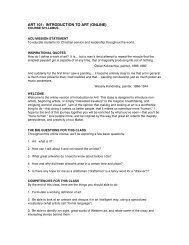pacifism in churches of christ in western canada during world
pacifism in churches of christ in western canada during world
pacifism in churches of christ in western canada during world
You also want an ePaper? Increase the reach of your titles
YUMPU automatically turns print PDFs into web optimized ePapers that Google loves.
PACIFISM IN CHURCHES OF CHRIST IN<br />
WESTERN CANADA DURING WORLD WAR II<br />
AND THE INFLUENCE OF NASHVILLE BIBLE<br />
SCHOOL*<br />
*I would like to thank John Mark Hicks for <strong>in</strong>troduc<strong>in</strong>g me to American Restoration<br />
theology and the theology <strong>of</strong> Nashville Bible School. Dr. Hicks has graciously guided the<br />
revision <strong>of</strong> this article, which began as a paper for his restoration theology course at<br />
Hard<strong>in</strong>g University Graduate School <strong>of</strong> Religion <strong>in</strong> spr<strong>in</strong>g 2005. I would also like to thank<br />
John Bailey, who read my paper and commented on the Canadian content. He has k<strong>in</strong>dly<br />
responded to numerous emails with requests for <strong>in</strong>formation about his father, J. C. Bailey.<br />
Last but not least, I would like to acknowledge the Canadian pioneer preachers who<br />
tirelessly preached the gospel <strong>in</strong> less than ideal circumstances, and <strong>of</strong>ten at great personal<br />
sacrifice.<br />
1 David Thompson, “The Restoration Movement <strong>in</strong> Ontario Part I,” Gospel Herald<br />
45, no. 1 (Jan. 1979): 7. Here<strong>in</strong>after referred to as GH.<br />
2<br />
SHELLEY L. JACOBS<br />
Western Christian College<br />
The Canadian primitivist movement that became associated with the American<br />
Restoration Movement (Stone-Campbell Movement) has its orig<strong>in</strong>s <strong>in</strong> the British<br />
tradition and was established by Scottish Baptists <strong>in</strong> the early n<strong>in</strong>eteenth century.<br />
The movement was well established <strong>in</strong> Ontario by the middle <strong>of</strong> the century and<br />
migrated west to the prairies (Manitoba, Saskatchewan, Alberta) <strong>in</strong> the early<br />
1<br />
twentieth century. Canadian restoration theology is rooted <strong>in</strong> the British tradi-<br />
2<br />
tion, and the British pacifistic <strong>in</strong>fluence was strong <strong>in</strong> Ontario. However, by the<br />
time the Canadian Restoration Movement moved west, the <strong>in</strong>fluence <strong>of</strong> the<br />
American South, particularly that <strong>of</strong> Nashville Bible School, was established <strong>in</strong><br />
See “Yearly Meet<strong>in</strong>g,” The Christian Banner 7, no. 8 (Aug. 1853): 221; [Brother]<br />
Wallace, “The Disciples and Carnal Warfare,” The Christian Banner 10, no. 9 (Sept.<br />
1856): 274–75; David Oliphant Jr., “Shall Christians Be Exempt from Military Duty?”<br />
The Christian Banner 8, no. 3 (March 1854): 71–73. From 1854 to 1856, the Disciples<br />
<strong>in</strong> Ontario discussed application for legal exemption from bear<strong>in</strong>g arms. David Oliphant<br />
was opposed to mak<strong>in</strong>g this move but advised the Disciples to apprise the government <strong>of</strong><br />
their pacifist stance on an <strong>in</strong>dividual basis. Had the Disciples applied for and been granted<br />
exemption, they would have enjoyed the same status <strong>of</strong> exemption as the historic peace<br />
<strong>churches</strong> <strong>in</strong> Canada.
212 RESTORATION QUARTERLY<br />
3<br />
Canada, and the <strong>in</strong>fluence <strong>of</strong> David Lipscomb fed the stream <strong>of</strong> <strong>pacifism</strong> <strong>in</strong> the<br />
4<br />
west. This paper will explore <strong>pacifism</strong> <strong>in</strong> <strong>western</strong> Canada through the pages <strong>of</strong><br />
the (Canadian) Gospel Herald and trace its connections to Nashville Bible<br />
School.<br />
Nashville Bible School<br />
Nashville Bible School was established <strong>in</strong> 1891 by David Lipscomb and<br />
James A. Hard<strong>in</strong>g <strong>in</strong> Nashville, Tennessee. It was a liberal arts college that<br />
required daily Bible study as part <strong>of</strong> the curriculum. Follow<strong>in</strong>g the death <strong>of</strong><br />
Lipscomb <strong>in</strong> 1917, the name <strong>of</strong> the school was changed to David Lipscomb<br />
5<br />
College. In 1901, Hard<strong>in</strong>g left Nashville Bible School to establish Potter Bible<br />
School <strong>in</strong> Bowl<strong>in</strong>g Green, Kentucky, and through the work <strong>of</strong> his students<br />
<strong>in</strong>fluenced the establishment <strong>of</strong> numerous Bible schools. Hard<strong>in</strong>g was considered<br />
the father <strong>of</strong> the Bible school movement among Churches <strong>of</strong> Christ, while<br />
Lipscomb was considered the father <strong>of</strong> the southern Churches <strong>of</strong> Christ. 6<br />
Foundational to the theology <strong>of</strong> Nashville Bible School is, what Richard<br />
Hughes has called, the “apocalyptic” <strong>world</strong>view. This <strong>world</strong>view is not neces-<br />
7<br />
sarily connected to theories regard<strong>in</strong>g “end times,” but is a <strong>world</strong>view based<br />
upon a k<strong>in</strong>gdom theology. It emphasizes Christian citizenship <strong>in</strong> a heavenly<br />
k<strong>in</strong>gdom, not an earthly one.<br />
One who holds to an apocalyptic orientation takes very seriously the promise<br />
<strong>of</strong> the end <strong>of</strong> this age and the assurance that the K<strong>in</strong>gdom <strong>of</strong> God will f<strong>in</strong>ally<br />
triumph. But more than that, he or she seeks to live his or her life as if the<br />
f<strong>in</strong>al triumph <strong>of</strong> the K<strong>in</strong>gdom <strong>of</strong> God were complete. For one who ascribes<br />
to this perspective, the K<strong>in</strong>gdom <strong>of</strong> God is not someth<strong>in</strong>g far <strong>of</strong>f <strong>in</strong> the<br />
future. Rather, the K<strong>in</strong>gdom <strong>of</strong> God is the def<strong>in</strong><strong>in</strong>g presence, the only reality<br />
that matters. 8<br />
Commitment to an apocalyptic <strong>world</strong>view calls for radical discipleship on<br />
the part <strong>of</strong> Christians. They are called to be non-materialistic, to m<strong>in</strong>ister to the<br />
3 Claude Cox, “The Division between Disciples and Churches <strong>of</strong> Christ <strong>in</strong> the<br />
Disciples Church at Meaford, Ontario,” ResQ 27, no.1 (Jan. 1984): 34.<br />
4 Lynn Anderson, email to author, 6 Dec. 2005; John Bailey, email to author, 20<br />
Nov. 2005.<br />
5 Robert E. Hooper, “Lipscomb University,” <strong>in</strong> The Encyclopedia <strong>of</strong> the Stone-<br />
Campbell Movement (eds. Douglas A. Foster, Paul M. Blowers, Anthony L. Dunnavant,<br />
D. Newell Williams; Grand Rapids: Eerdmans, 2004), 482–83.<br />
6 John Mark Hicks and Bobby Valent<strong>in</strong>e, K<strong>in</strong>gdom Come: Embrac<strong>in</strong>g the Spiritual<br />
Legacy <strong>of</strong> David Lipscomb and James Hard<strong>in</strong>g (Abilene: Leafwood, 2006), 21–22.<br />
7 Richard T. Hughes, Reviv<strong>in</strong>g the Ancient Faith: The Story <strong>of</strong> Churches <strong>of</strong> Christ<br />
<strong>in</strong> America (Grand Rapids: Eerdmans, 1996), 92.<br />
8 Richard T. Hughes, Reclaim<strong>in</strong>g a Heritage: Reflections on the Heart, Soul and<br />
Future <strong>of</strong> Churches <strong>of</strong> Christ (Abilene: ACU Press, 2002), 73.
JACOBS/PACIFISM IN CHURCHES OF CHRIST IN CANADA 213<br />
poor and suffer<strong>in</strong>g, to live peaceful lives, and to be obedient servants <strong>of</strong> Christ<br />
despite any cost. Christians are called to live counter culturally, and not <strong>in</strong> step<br />
with the <strong>world</strong>. 9<br />
The apocalyptic <strong>world</strong>view with<strong>in</strong> the American Restoration tradition orig<strong>in</strong>ated,<br />
accord<strong>in</strong>g to Hughes, with Barton Stone, for whom it was “premised on<br />
10<br />
obedience to the direct rule <strong>of</strong> God.” Christians are pilgrims on earth, and their<br />
11<br />
allegiance is to God, not current <strong>world</strong>ly values. Stone believed that “the k<strong>in</strong>gdom<br />
<strong>of</strong> God transcends the church on this earth. He envisioned the k<strong>in</strong>gdom as<br />
God’s f<strong>in</strong>al, triumphant rule, which will be made complete only <strong>in</strong> the last age.”<br />
12<br />
He believed that Scripture gave “models for holy liv<strong>in</strong>g” and was sectarian <strong>in</strong><br />
13<br />
that he believed <strong>in</strong> separation from the <strong>world</strong>. Stone, toward the end <strong>of</strong> his life,<br />
rejected politics and <strong>in</strong>volvement <strong>in</strong> government and held an ethic <strong>of</strong> <strong>pacifism</strong><br />
that was “grounded . . . squarely <strong>in</strong> anticipation <strong>of</strong> the f<strong>in</strong>al triumph <strong>of</strong> the k<strong>in</strong>g-<br />
14<br />
dom <strong>of</strong> God on earth.”<br />
15<br />
David Lipscomb embodied the apocalyptic <strong>world</strong>view <strong>of</strong> Stone. He held<br />
a strong k<strong>in</strong>gdom theology, was sectarian, rejected politics, and was a “rigorous<br />
16<br />
pacifist.” He believed that human government was an <strong>in</strong>stitution that belonged<br />
to Satan and that Christians should have no <strong>in</strong>volvement with the government or<br />
its affairs. “The chief occupation <strong>of</strong> human governments from the beg<strong>in</strong>n<strong>in</strong>g have<br />
been war.” Therefore, “[i]t [takes] but little thought to see that Christians cannot<br />
fight, cannot slay one another or their fellowmen, at the behest <strong>of</strong> any earthly<br />
17<br />
ruler, or to establish or ma<strong>in</strong>ta<strong>in</strong> any human government.” He believed that the<br />
role <strong>of</strong> the church was to establish the k<strong>in</strong>gdom <strong>of</strong> God on earth <strong>in</strong> order to<br />
establish div<strong>in</strong>e rule and displace Satan’s earthly government. 18<br />
For Lipscomb, the Sermon on the Mount represented the core pr<strong>in</strong>ciples <strong>of</strong><br />
Jesus’ teach<strong>in</strong>g. Jesus’ mission to earth was to “rescue the <strong>world</strong>” from a fallen<br />
19<br />
state and restore it to “primitive and prist<strong>in</strong>e allegiance” to God. The pr<strong>in</strong>ciples<br />
found <strong>in</strong> the Sermon on the Mount were <strong>in</strong>tended to be “the pr<strong>in</strong>ciples that must<br />
9 Hughes, Reclaim<strong>in</strong>g a Heritage, 74–77.<br />
10 Hughes, Reviv<strong>in</strong>g the Ancient Faith, 92.<br />
11 Ibid., 93.<br />
12 Ibid., 94.<br />
13 Ibid., 109.<br />
14 Ibid., 111.<br />
15 Hughes <strong>in</strong>dicates that Lipscomb was the last one to comb<strong>in</strong>e successfully the<br />
viewpo<strong>in</strong>ts <strong>of</strong> both Stone and Campbell. For the purpose <strong>of</strong> this paper, the <strong>in</strong>fluence <strong>of</strong><br />
Stone’s apocalyptic <strong>world</strong>view will be discussed.<br />
16 Hughes, Reviv<strong>in</strong>g the Ancient Faith, 121–27.<br />
17 David Lipscomb, Civil Government: Its Orig<strong>in</strong>, Mission and Dest<strong>in</strong>y and the<br />
Christian’s Relation to It (Nashville: McQuiddy, 1913), iv. Electronic resource found at<br />
http://www.mun.ca/rels/restmov/texts/dlipscomb/civgov.html.<br />
18 Lipscomb, Civil Government, 12–13.<br />
19 Ibid., 46–47.
214 RESTORATION QUARTERLY<br />
20<br />
govern <strong>in</strong> his k<strong>in</strong>gdom.” Lipscomb believed that these pr<strong>in</strong>ciples were essential<br />
to Christian liv<strong>in</strong>g and must “pervade and control the hearts and lives <strong>of</strong> men,<br />
21<br />
without which no man can be a Christian.” He believed that “Christ specially<br />
gave this sermon to regulate the hearts and lives <strong>of</strong> his followers. He gave it at the<br />
beg<strong>in</strong>n<strong>in</strong>g <strong>of</strong> his m<strong>in</strong>istry that all might understand the life, to which they were<br />
22<br />
specifically called.” Christians are citizens <strong>of</strong> heaven who are called to walk as<br />
Jesus did, which means promot<strong>in</strong>g love, <strong>in</strong>clud<strong>in</strong>g love <strong>of</strong> one’s enemies. 23<br />
Lipscomb was the primary spokesperson for the pacifistic vision <strong>of</strong> Nashville<br />
24<br />
Bible School. He argued, “Jesus would not permit his servants to take the sword<br />
to defend him, to establish his rule on earth, or to ma<strong>in</strong>ta<strong>in</strong> his k<strong>in</strong>gdom and fight<br />
25<br />
aga<strong>in</strong>st God’s enemies.” Christians should not fight and kill one another <strong>in</strong> the<br />
name <strong>of</strong> war for the establishment <strong>of</strong> earthly k<strong>in</strong>gdoms. Not only should Christians<br />
refra<strong>in</strong> from participation <strong>in</strong> war, Lipscomb went so far as to argue that<br />
vot<strong>in</strong>g to elect a government that might support war was equally contrary to<br />
26<br />
Jesus’ wishes. He posed the question, “Does anyone believe that if Jesus were<br />
here that he would make war speeches and encourage the spirit <strong>of</strong> war?” He<br />
concludes that “true followers” <strong>of</strong> Jesus must not participate <strong>in</strong> human conflict<br />
and strife. “The evil beg<strong>in</strong>s <strong>in</strong> participat<strong>in</strong>g <strong>in</strong> the political strifes and conflicts <strong>of</strong><br />
human governments, dr<strong>in</strong>k<strong>in</strong>g <strong>in</strong>to a spirit that is <strong>of</strong> man and not <strong>of</strong> God. Unless<br />
we have the spirit <strong>of</strong> Christ, we are none <strong>of</strong> his.” 27<br />
28<br />
Hard<strong>in</strong>g, the “epitome <strong>of</strong> the apocalyptic tradition,” shared Lipscomb’s<br />
view that human government is an agency <strong>of</strong> Satan, and as such, that Christians<br />
29<br />
should not be <strong>in</strong>volved <strong>in</strong> the affairs <strong>of</strong> human government. He extended that<br />
to <strong>in</strong>clude “any <strong>in</strong>stitution or k<strong>in</strong>gdom reflect<strong>in</strong>g human contrivance,” <strong>in</strong>clud<strong>in</strong>g<br />
30<br />
missionary societies and a govern<strong>in</strong>g board for Nashville Bible School. Hard<strong>in</strong>g<br />
placed his trust <strong>in</strong> the providence <strong>of</strong> God, not human <strong>in</strong>stitutions. 31<br />
20 Ibid., 57.<br />
21 Ibid., 133.<br />
22 Ibid., 135.<br />
23 David Lipscomb, “War—Its Spirit,” Gospel Advocate 40 (28 April 1898): 269.<br />
24 Michael Casey, “Pacifism and David Lipscomb,” The Gospel Advocate 135, no.<br />
12 (Dec. 1993): 46; Johnnie Andrew Coll<strong>in</strong>s, “Pacifism <strong>in</strong> the Churches <strong>of</strong> Christ:<br />
1866–1945,” (D.A. dissertation, Middle Tennessee State University, 1984), 68.<br />
25 David Lipscomb, “The Monroe Doctr<strong>in</strong>e,” Gospel Advocate 38, no. 3 (16 Jan.<br />
1896): 37; Lipscomb, Civil Government, iv.<br />
26 Lipscomb, “War—Its Spirit,” 269; Lipscomb, Civil Government, iv.<br />
27 Lipscomb, “War—Its Spirit,” 269.<br />
28 Hughes, Reviv<strong>in</strong>g the Ancient Faith, 138.<br />
29 James A. Hard<strong>in</strong>g, “The K<strong>in</strong>gdom <strong>of</strong> Christ Vs. The K<strong>in</strong>gdom <strong>of</strong> Satan,” The Way<br />
5, no. 26 (15 Oct. 1903), 931. Available at www.mun.ca/rels/restmov/texts/jhard<strong>in</strong>g/K<br />
CVKS.HTM.<br />
30 Hughes, Reviv<strong>in</strong>g the Ancient Faith, 137–38.<br />
31 Ibid.
JACOBS/PACIFISM IN CHURCHES OF CHRIST IN CANADA 215<br />
Hard<strong>in</strong>g’s theology <strong>in</strong>cluded a strong view <strong>of</strong> God’s overrid<strong>in</strong>g providence<br />
32<br />
<strong>in</strong> the affairs <strong>of</strong> humank<strong>in</strong>d, a dynamic and active role <strong>of</strong> the <strong>in</strong>dwell<strong>in</strong>g Holy<br />
33<br />
Spirit <strong>in</strong> the life <strong>of</strong> a believer, and a fourfold practice <strong>of</strong> spiritual discipl<strong>in</strong>e as<br />
a means <strong>of</strong> grace that consisted <strong>of</strong> read<strong>in</strong>g and study<strong>in</strong>g the Bible, m<strong>in</strong>ister<strong>in</strong>g to<br />
the poor, observ<strong>in</strong>g the Lord’s day meet<strong>in</strong>g and the Lord’s Supper, and prayer. 34<br />
Hard<strong>in</strong>g was also premillennial, and his millennial views “reflected a deeper<br />
<strong>world</strong>view” that was premised on his k<strong>in</strong>gdom theology. 35<br />
32 Hicks and Valent<strong>in</strong>e, 45–48.<br />
33 Ibid., 32.<br />
34 Ibid., 75–76.<br />
35 Hughes, Reviv<strong>in</strong>g the Ancient Faith, 137.<br />
36 L. C. Sears, The Eyes <strong>of</strong> Jehovah: The Life and Faith <strong>of</strong> James Alexander Hard<strong>in</strong>g<br />
(Nashville: Gospel Advocate Co., 1970), 49.<br />
37 Cox, 25–29.<br />
38 Ibid., 29.<br />
39 Ibid., 29.<br />
40<br />
Canada and Nashville Bible School<br />
Hard<strong>in</strong>g’s <strong>in</strong>fluence moved <strong>in</strong>to Canada prior to the establishment <strong>of</strong><br />
Nashville Bible School. By 1883 he had preached <strong>in</strong> two Canadian prov<strong>in</strong>ces,<br />
36<br />
Manitoba and Ontario. Two significant locations were Meaford, Ontario, and<br />
Carman, Manitoba.<br />
The Disciples church <strong>in</strong> Meaford met for the first time <strong>in</strong> the spr<strong>in</strong>g <strong>of</strong> 1848.<br />
It grew and built its first build<strong>in</strong>g <strong>in</strong> 1858, and by 1861 had a membership <strong>of</strong> one<br />
hundred. The Meaford Disciples were evangelistically m<strong>in</strong>ded and started congregations<br />
<strong>in</strong> nearby Cape Rich and the Euphrasia Township <strong>in</strong> the 1870s. They<br />
worked cooperatively with seven other congregations to secure a full-time<br />
evangelist for their county, the County Grey. In 1882, they formed a cooperative<br />
with the Euphrasia and Cape Rich congregations <strong>in</strong> order to secure the services<br />
<strong>of</strong> a full-time preacher to work with the three congregations. But by 1900, the<br />
Meaford congregation had withdrawn from cooperation with other congregations. 37<br />
Claude Cox identifies two reasons for the distanc<strong>in</strong>g <strong>of</strong> the Meaford<br />
38<br />
Disciples from the cooperative and <strong>in</strong>strumental stream <strong>of</strong> the movement. First<br />
is the <strong>in</strong>fluence <strong>of</strong> James Beaty and the Bible Index, which was a Canadian<br />
restoration periodical published <strong>in</strong> Toronto, Ontario. Beaty was opposed to<br />
cooperations and the use <strong>of</strong> the organ and promoted these viewpo<strong>in</strong>ts <strong>in</strong> his<br />
paper. Second is the <strong>in</strong>fluence <strong>of</strong> visit<strong>in</strong>g preachers from the “American South.” 39<br />
40<br />
James A. Hard<strong>in</strong>g held his first debate <strong>in</strong> Meaford, Ontario, <strong>in</strong> 1884 and<br />
41<br />
returned to hold protracted meet<strong>in</strong>gs <strong>in</strong> 1885 and 1896. The church records<br />
from Meaford identify five additional preachers with connections to Hard<strong>in</strong>g and<br />
James A. Hard<strong>in</strong>g and the Rev. T. L. Wilk<strong>in</strong>son, Debate on Baptism: Embrac<strong>in</strong>g<br />
Mode and Subjects (Toronto: William Briggs, 1886).<br />
41 Cox, 31–32.
216 RESTORATION QUARTERLY<br />
Nashville Bible School who held protracted meet<strong>in</strong>gs <strong>in</strong> Meaford: Abraham<br />
42 43 44<br />
Foster (1897 and 1898), S. M. Jones (1899 and 1901), E. A. Elam (1899 and<br />
45 46 47<br />
1900), J. T. Lewis (1904 and 1905), and Don Carlos Janes (1915).<br />
Cox concludes that “[f]irm ties with the South and Nashville, <strong>in</strong> particular,<br />
were forged through contacts with J. A. Hard<strong>in</strong>g. . . . [B]y the turn <strong>of</strong> the century<br />
the Meaford Disciples church had strong ties with Southern, conservative views,<br />
48<br />
especially those current at Nashville.” These ties grew stronger follow<strong>in</strong>g the<br />
division between the Church <strong>of</strong> Christ and the Disciples <strong>in</strong> Meaford. The<br />
division, which began <strong>in</strong> the 1880s, gradually progressed over a number <strong>of</strong> years<br />
and was formally recognized <strong>in</strong> 1919. 49<br />
The Meaford congregation played a significant role <strong>in</strong> the establishment and<br />
development <strong>of</strong> Churches <strong>of</strong> Christ <strong>in</strong> the Canadian west. The congregation <strong>in</strong><br />
Carman, Manitoba, was established by the Saunders and Mallory families from<br />
50<br />
Meaford, who moved west <strong>in</strong> 1889 for that purpose. They were the first <strong>of</strong> many<br />
families who moved from Meaford to the prairies. The first meet<strong>in</strong>g <strong>of</strong> the<br />
Church <strong>of</strong> Christ <strong>in</strong> Carman was held <strong>in</strong> the home <strong>of</strong> George Saunders <strong>in</strong> 1889.<br />
Over the next few years, others from Ontario jo<strong>in</strong>ed them, and by 1891, membership<br />
was large enough for the congregation to build their first build<strong>in</strong>g.<br />
Carman’s connections to Meaford, and thus to Nashville Bible School, are<br />
evidenced <strong>in</strong> the list <strong>of</strong> visit<strong>in</strong>g preachers. James A. Hard<strong>in</strong>g preached at the<br />
open<strong>in</strong>g ceremony for the new build<strong>in</strong>g <strong>in</strong> 1892 and returned to preach a<br />
51<br />
protracted meet<strong>in</strong>g <strong>in</strong> 1893. E. A. Elam preached <strong>in</strong> Carman <strong>in</strong> 1895; Abraham<br />
Foster was <strong>in</strong> residence from 1898–1903; and S. M. Jones preached <strong>in</strong> Carman<br />
42 Catalogue <strong>of</strong> Nashville Bible School, impr<strong>in</strong>t Nashville, TN: Gospel Advocate<br />
Pub. Co., 1894–1897. Foster attended Nashville Bible School from 1894– 1897.<br />
43 Catalogue <strong>of</strong> Nashville Bible School, 1894–1898. Jones attended Nashville Bible<br />
School from 1894–1898.<br />
44 H. Leo Boles, “E. A. Elam and David Lipscomb College,” Gospel Advocate 71,<br />
no. 17 (25 April 1929), 388. Elam was appo<strong>in</strong>ted to the board <strong>of</strong> directors <strong>of</strong> Nashville<br />
Bible School <strong>in</strong> 1901 and served 28 years <strong>in</strong> that capacity. Dur<strong>in</strong>g that time he also served<br />
as president <strong>of</strong> Nashville Bible School from 1907–1913.<br />
45 Catalogue <strong>of</strong> Nashville Bible School, 1899–1906. Lewis attended the NBS from<br />
1899–1906.<br />
46 J. N. Armstrong, “Don Carlos Janes,” Gospel Advocate 86, no. 12 (23 March<br />
1944): 202. Janes attended Potter Bible College from 1901–1905.<br />
47 Cox, 31–33. It should be noted that preachers from other areas <strong>of</strong> the United States<br />
also held protracted meet<strong>in</strong>gs <strong>in</strong> Meaford.<br />
48 Cox, 33–34.<br />
49 Ibid., 34–36.<br />
50 Rueben Butchart, The Disciples <strong>of</strong> Christ <strong>in</strong> Canada S<strong>in</strong>ce 1830 (Toronto:<br />
Canadian Headquarters’ Publications, Churches <strong>of</strong> Christ [Disciples], 1949), 418.<br />
51 Elizabeth York, “Carman Church <strong>of</strong> Christ,” <strong>in</strong> Up To Now: A Story <strong>of</strong> Duffer<strong>in</strong><br />
and Carman (Altona, MB: D. W. Friesen & Sons Ltd., 1967), 127–28.
JACOBS/PACIFISM IN CHURCHES OF CHRIST IN CANADA 217<br />
52<br />
<strong>in</strong> 1907. These men also held protracted meet<strong>in</strong>gs <strong>in</strong> Meaford. The Church <strong>of</strong><br />
Christ <strong>in</strong> Carman was the first established congregation <strong>of</strong> Churches <strong>of</strong> Christ <strong>in</strong><br />
<strong>western</strong> Canada, and Nashville <strong>in</strong>fluence formed part <strong>of</strong> its earliest history.<br />
The Bible School movement that began <strong>in</strong> Nashville also impacted Canadians.<br />
A significant number <strong>of</strong> Canadians traveled south to be tra<strong>in</strong>ed at Nashville<br />
Bible School. School records <strong>in</strong>dicate that twenty-three Canadians attended<br />
Nashville Bible School from 1895 to 1917. Included <strong>in</strong> that number are ten<br />
53<br />
students from Meaford and five from the Carman area. American students <strong>of</strong><br />
Nashville Bible School also came to Canada and established the first Bible<br />
Schools <strong>in</strong> Canada.<br />
54<br />
The Carman Bible School was established <strong>in</strong> 1897 by Abraham Foster, a<br />
55<br />
student <strong>of</strong> Nashville Bible School. The first Bible school among the Churches<br />
<strong>of</strong> Christ <strong>in</strong> Canada, it was patterned after Nashville Bible School. No tuition fees<br />
were charged, and students were responsible for f<strong>in</strong>d<strong>in</strong>g their own accommodation.<br />
In addition to Bible, the school <strong>of</strong>fered courses <strong>in</strong> liberal arts. The school<br />
came to an untimely close after a flood caused irreparable damage to the build<strong>in</strong>gs.<br />
Lillian Torkelson, founder <strong>of</strong> Western Christian College, says <strong>of</strong> Foster,<br />
“The <strong>in</strong>fluence Brother Foster exerted over his students cannot be measured. He<br />
is certa<strong>in</strong>ly one <strong>of</strong> the great pioneers <strong>of</strong> Christian education <strong>in</strong> Canada.” 56<br />
The second Bible School <strong>in</strong> Canada was established by S. M. Jones, also a<br />
57<br />
student <strong>of</strong> Nashville Bible School. Hard<strong>in</strong>g sent Jones to Canada to preach a<br />
52 W. Eatough, “The Church at Carman” GH 7, no. 1 (March 1941): 10.<br />
53 Catalogue <strong>of</strong> Nashville Bible School, impr<strong>in</strong>t Nashville, TN: Gospel Advocate<br />
Pub. Co., 1894–1897; The . . . annual announcement <strong>of</strong> Nashville Bible School, impr<strong>in</strong>t<br />
Nashville, TN: Gospel Advocate Pub. Co., 1898–1917; Nashville Bible School bullet<strong>in</strong>,<br />
impr<strong>in</strong>t Nashville, TN; Nashville Bible School, 1915–1917. Those from Meaford (and the<br />
years attended) are William Cox (1899–1900), John Deegan (1899–1900), Emma V. Falls<br />
(1897–99), John Jay (1899–1900), W. J. (or W. T.) Mackie (1897–00), Charles W. Petch<br />
(1899–1902), Mrs. Charles Petch (1899–1902), W. E. Trout (1897–98), Samuel Whitfield<br />
(1897–98) and Maud York (1899–1901). Those from Carman (and the years attended) are<br />
John Mallory (1895–99), Norman Mallory (1897–1900), Wilson Mallory (1895–99), John<br />
Saunders (1897–98; 1900–1901) and Stanely York (1899–1901). Those from other<br />
locations are George E. Clause (1897–1902) St. Cather<strong>in</strong>es, Ontario; Annie C. Hamm<br />
(1915–16), no location given; Henry David Jackson (1899–1901), Jordan Station,<br />
Ontario; (J. D. or J. C.) McMurchie (1895–99), no location given; C. G. McPhee (Grad<br />
1917), no location given; E. Sterl<strong>in</strong>g (1895–97), no location given; Madison Wright<br />
(1899–1901), no location given.<br />
54 Lillian Torkelson, Radburn’s Memoirs (Wichita Falls, TX: Western Christian<br />
Foundation Press, 1970), 118–19.<br />
55 Catalogue <strong>of</strong> Nashville Bible School, 1894–1897. Foster attended Nashville Bible<br />
School from 1894–1897.<br />
56 Torkelson, Radburn’s Memoirs, 118–20.<br />
57 Catalogue <strong>of</strong> Nashville Bible School, 1894–1898. Jones attended Nashville Bible<br />
School from 1894–1898.
218 RESTORATION QUARTERLY<br />
58<br />
gospel meet<strong>in</strong>g <strong>in</strong> Meaford, and Jones rema<strong>in</strong>ed <strong>in</strong> Canada. In 1898 he held a<br />
successful protracted meet<strong>in</strong>g <strong>in</strong> Beamsville and <strong>in</strong> 1902 established the<br />
59<br />
Beamsville Bible School. The Bible School was organized <strong>in</strong> the same fashion<br />
as the Carman Bible School. It was a non-residential school, but students from<br />
around the prov<strong>in</strong>ce attended and boarded <strong>in</strong> the homes <strong>of</strong> church members. The<br />
curriculum <strong>in</strong>cluded Bible and liberal arts courses. Jones was “one <strong>of</strong> the most<br />
controversial and at the same time one <strong>of</strong> the most <strong>in</strong>fluential persons <strong>in</strong> the<br />
60<br />
history <strong>of</strong> the Beamsville church.” He was opposed to the use <strong>of</strong> the organ and<br />
to missionary societies and was considered partially responsible for the division<br />
<strong>of</strong> the Beamsville congregation <strong>in</strong> 1910. Follow<strong>in</strong>g the division, Jones and those<br />
who sided with him moved to a new build<strong>in</strong>g down the street, and Jones moved<br />
the Beamsville Bible School to the new location. The Bible School ran until<br />
61<br />
1916, and Jones rema<strong>in</strong>ed <strong>in</strong> Beamsville until his death <strong>in</strong> 1934. The Beamsville<br />
congregation was reunited <strong>in</strong> 1936 under the leadership <strong>of</strong> C. G. McPhee. 62<br />
The Carman Bible School was resurrected <strong>in</strong> 1921 when H. A. Rogers, a<br />
student <strong>of</strong> the earlier Bible School, recognized the need for a Bible School <strong>in</strong><br />
63<br />
<strong>western</strong> Canada. Rogers had moved with his family from Meaford <strong>in</strong> 1899 and<br />
operated a market garden out <strong>of</strong> Carman. In 1917 the Carman congregation sent<br />
64<br />
him <strong>in</strong>to Saskatchewan to evangelize. He was the first preacher to evangelize<br />
<strong>in</strong> that prov<strong>in</strong>ce and laid the foundation for Churches <strong>of</strong> Christ <strong>in</strong> Saskatchewan.<br />
65<br />
By 1918 Rogers had baptized at least fifty people, and by 1920 he had<br />
established a number <strong>of</strong> small congregations <strong>in</strong> Saskatchewan. Rogers persuaded<br />
H. L. Richardson to move from Ontario to Carman to re-open the school.<br />
66<br />
Richardson’s father had encouraged Rogers to preach, and Richardson sent<br />
occasional reports <strong>of</strong> Rogers’s work <strong>in</strong> <strong>western</strong> Canada to Word and Work. 67<br />
Richardson had attended the Beamsville Bible School and studied under S. M.<br />
68<br />
Jones. The pend<strong>in</strong>g open<strong>in</strong>g <strong>of</strong> the Carman Bible School received mention <strong>in</strong><br />
69 70<br />
the Christian Leader and Word and Work. The Carman Bible School <strong>of</strong>fered<br />
58 Sears, 156.<br />
59 Edw<strong>in</strong> Broadus and Steve Courson, eds. A Church Upon the New Testament<br />
Alone: The History <strong>of</strong> the Beamsville Church <strong>of</strong> Christ: 1832–1982 (Beamsville, ON:<br />
Beamsville Church <strong>of</strong> Christ, 1982), 9–10.<br />
60 Broadus and Courson, 10.<br />
61 Ibid., 10–11.<br />
62 Ibid., 13.<br />
63 Torkelson, Radburn’s Memoirs, 120.<br />
64 “News and Notes,” Word and Work 10, no. 2 (Feb. 1917): 57. Word and Work is<br />
available at http://www.mun.ca/rels/restmov/people/rboll.html.<br />
65 “News and Notes,” Word and Work 11, no. 1 (Jan. 1918): 6.<br />
66 J. C. Bailey, “Memories,” GH 45, no. 11 (Nov. 1979): 3.<br />
67 “News and Notes,” Word and Work 12, no. 1 (Jan. 1918): 6.<br />
68 J. C. Bailey, “Memories,” 3.<br />
69 “Field Reports,” Christian Leader 35, no. 26 (28 June 1921): 13.<br />
70 “News and Notes,” Word and Work 14, no. 9 (Sept. 1921): 264.
JACOBS/PACIFISM IN CHURCHES OF CHRIST IN CANADA 219<br />
a three-year program that <strong>in</strong>cluded both commercial subjects and Bible. 71<br />
Richardson was a capable teacher and well respected, but he was premillennial,<br />
72<br />
and this resulted <strong>in</strong> dissension at the school. Richardson rema<strong>in</strong>ed until 1926,<br />
then moved back to Ontario. The school operated for one more term and closed<br />
73<br />
its doors <strong>in</strong> the spr<strong>in</strong>g <strong>of</strong> 1927. J. C. Bailey expresses “deep regret” that “[i]n<br />
a few years [Richardson] went to the Christian church and left the fellowship <strong>of</strong><br />
the church. This was a severe blow to the church <strong>in</strong> Western Canada.” 74<br />
Individuals from Meaford cont<strong>in</strong>ued to move west to homestead on the<br />
prairies, and congregations were established as a result. Russell and Annie Elford<br />
moved from Meaford to Saskatchewan <strong>in</strong> 1911 and homesteaded <strong>in</strong> the Horse<br />
75<br />
Creek area <strong>in</strong> 1916. As there was no established Church <strong>of</strong> Christ <strong>in</strong> his district,<br />
Elford established an Undenom<strong>in</strong>ational Union Sunday School, which met at<br />
Lark Hill School, half a mile from the Elford homestead. He was the super<strong>in</strong>tendent<br />
for the duration <strong>of</strong> the school, which was dissolved once a Church <strong>of</strong><br />
Christ had been established <strong>in</strong> the area. 76<br />
Charles Wesley Petch came to Horse Creek at the request <strong>of</strong> Elford, his<br />
brother-<strong>in</strong>-law, to hold protracted meet<strong>in</strong>gs. Petch and his wife were among the<br />
Canadians from Meaford who had attended Nashville Bible School from<br />
77 78<br />
1899–1902. Petch also attended one session <strong>of</strong> the early Carman Bible School.<br />
79<br />
He subscribed to Word and Work, and reports <strong>of</strong> his work <strong>in</strong> the Horse Creek<br />
district were pr<strong>in</strong>ted <strong>in</strong> the “News and Notes” column <strong>of</strong> the publication. Petch<br />
80<br />
visited Horse Creek and held protracted meet<strong>in</strong>gs <strong>in</strong> 1919 and 1927, with no<br />
71 Torkelson, Radburn’s Memoirs, 120.<br />
72 J. C. Bailey, My Appo<strong>in</strong>tment with Dest<strong>in</strong>y (Fort Worth, TX: Star Bible & Tract<br />
Corp.: n.d.), 15.<br />
73 Torkelson, Radburn’s Memoirs, 121.<br />
74<br />
J. C. Bailey, “Memories,” 3; J. C. Bailey, Forty Years a Canadian Preacher<br />
(Abilene, TX: Matthews Pr<strong>in</strong>t<strong>in</strong>g Company, n.d.), 33. Bailey states that Richardson left<br />
the “Ancient Paths” soon after leav<strong>in</strong>g Carman and that <strong>in</strong> later years, he attempted to<br />
“restore” Richardson, but was unsuccessful.<br />
75 Pansy Bien, “Russell and Annie Elford,” <strong>in</strong> From Prairie Grass to Wheat Fields:<br />
A History <strong>of</strong> McCord and Area (Altona, MB: Friesens Corp., 2001), 244.<br />
76<br />
Pansy Elford Bien, <strong>in</strong>terview by author, 18 March 2005, Moose Jaw, SK, tape<br />
record<strong>in</strong>g. The establishment <strong>of</strong> the Undenom<strong>in</strong>ational Bible School supports Cox’s<br />
conclusion that the split between the Disciples and Church <strong>of</strong> Christ <strong>in</strong> Meaford was not<br />
yet solidified. When Elford came west, he associated and worked with people from the<br />
Disciples group who had moved from Ontario to Saskatchewan. For the duration <strong>of</strong> his<br />
lifetime, he ma<strong>in</strong>ta<strong>in</strong>ed a friendship with a family from the “digressives,” but they never<br />
worshipped together.<br />
77 Catalogue <strong>of</strong> Nashville Bible School, 1899–1902.<br />
78 “Chas. W. Petch, Evangelist,” Bible Student 4, no. 7 (July 1907): 1. The year <strong>of</strong><br />
his attendance is not <strong>in</strong>dicated.<br />
79<br />
Petch sent regular address changes that were pr<strong>in</strong>ted <strong>in</strong> “News and Notes.” “News<br />
and Notes,” Word and Work 20, no. 8 (Aug. 1927), 229.<br />
80 J. C. Bailey, “The Horse Creek District,” <strong>in</strong> How the Church Began and Grew <strong>in</strong>
220 RESTORATION QUARTERLY<br />
81 82<br />
response to the gospel message. In 1927 he relocated to W<strong>in</strong>nipeg, Manitoba,<br />
and cont<strong>in</strong>ued to hold protracted meet<strong>in</strong>gs at Horse Creek. The first baptisms <strong>in</strong><br />
83 84<br />
the area took place <strong>in</strong> 1928. Petch relocated to Horse Creek <strong>in</strong> 1930 and<br />
85<br />
rema<strong>in</strong>ed there until 1932. By December 1931, Petch was teach<strong>in</strong>g four Bible<br />
86<br />
studies per week, and the books <strong>of</strong> Hebrews and Revelation were among the<br />
87<br />
topics <strong>of</strong> study. Petch wrote, “Our studies <strong>in</strong> Revelation at Horse Creek gave me<br />
a new <strong>in</strong>sight <strong>in</strong>to its teach<strong>in</strong>g and opened it up to the church there as they had<br />
88<br />
never seen it.” His work <strong>in</strong> that area established four congregations, named for<br />
the schoolhouses <strong>in</strong> which they met. They later merged <strong>in</strong>to what became known<br />
as the Horse Creek congregation. It became one <strong>of</strong> the strongest congregations<br />
<strong>in</strong> Saskatchewan <strong>in</strong> the 1930s. 89<br />
90<br />
Petch held premillennial views and was also a pacifist. His nephew, Edw<strong>in</strong><br />
Elford, recalls that Petch’s <strong>pacifism</strong> went beyond fight<strong>in</strong>g <strong>in</strong> war and extended<br />
to the Christian’s attitude toward relations with other Christians. “He taught<br />
aga<strong>in</strong>st any form <strong>of</strong> fight<strong>in</strong>g. It’s not just war, but how we treat our brothers.<br />
There’s a responsibility as a Christian <strong>in</strong> how we treat our neighbor.” 91<br />
John Carlos (J. C.) Bailey moved from Meaford to Carman <strong>in</strong> 1921 to attend<br />
the Carman Bible School. Bailey’s roots <strong>in</strong> the Restoration Movement extend<br />
back to 1882, when his maternal grandparents were baptized <strong>in</strong>to the Disciples<br />
92<br />
church <strong>in</strong> Grey County, Ontario. His mother, Edith Cann, was baptized at<br />
93<br />
Meaford <strong>in</strong> 1896 by James A. Hard<strong>in</strong>g. His father, Thomas Bailey, was baptized<br />
94<br />
at Meaford <strong>in</strong> 1901 by Don Carlos Janes, and John Carlos Bailey was named<br />
95<br />
after him. Bailey was enrolled <strong>in</strong> the three-year program at the Bible School, but<br />
Saskatchewan, (n.p., n.d.), 79.<br />
81 Pansy Elford Bien, <strong>in</strong>terview.<br />
82 “News and Notes,” Word and Work 20, no. 8 (Aug. 1927): 229.<br />
83 Pansy Elford Bien, <strong>in</strong>terview.<br />
84 “News and Notes,” Word and Work 23, no. 6 (June 1930): 169.<br />
85 Ibid., 25, no. 5 (May 1932): 119.<br />
86 Ibid., 24, no. 12 (Dec. 1931): 306.<br />
87 Ibid., 24, no. 1 (Jan. 1931): 6.<br />
88 Ibid., 24, no. 4 (April 1931): 102. Petch taught the book <strong>of</strong> Revelation dur<strong>in</strong>g the<br />
time frame that Boll was advertis<strong>in</strong>g his commentary on Revelation <strong>in</strong> Word and Work.<br />
Unfortunately, Petch does not <strong>in</strong>dicate whether he used Boll’s commentary for this Bible<br />
study.<br />
89 J. C. Bailey, “The Horse Creek District,” 79–80.<br />
90 Robert S<strong>in</strong>clair, <strong>in</strong>terview by author, 29 March 2005, Reg<strong>in</strong>a, SK, telephone<br />
<strong>in</strong>terview; “News and Notes,” Word and Work 32, no. 6 (June 1938): 123.<br />
91 Edw<strong>in</strong> Elford, <strong>in</strong>terview by author, 18 March 2005, Moose Jaw, SK, tape<br />
record<strong>in</strong>g.<br />
92 J. C. Bailey, Forty Years a Canadian Preacher, 9–10.<br />
93 The Meaford Journals, 1848–1998 (Meaford: Stan Brown Pr<strong>in</strong>ters Ltd., 1998): 45.<br />
94 The Meaford Journals, 48.<br />
95 Cecil Bailey, <strong>in</strong>terview by author, 17 April 2005, Reg<strong>in</strong>a, SK, telephone <strong>in</strong>terview.
JACOBS/PACIFISM IN CHURCHES OF CHRIST IN CANADA 221<br />
left after two years because he disagreed with Richardson’s premillennial views. 96<br />
He preached <strong>in</strong> Montana and Ontario before return<strong>in</strong>g to <strong>western</strong> Canada <strong>in</strong><br />
97<br />
1928. Aside from Petch, Bailey was the only full-time, located preacher <strong>in</strong><br />
Saskatchewan <strong>in</strong> the early years. He rema<strong>in</strong>ed after Petch returned to Ontario <strong>in</strong><br />
1932, and his <strong>in</strong>fluence significantly shaped Churches <strong>of</strong> Christ <strong>in</strong> Saskatchewan.<br />
Rogers, Petch, and Bailey began the work <strong>in</strong> Saskatchewan and built the<br />
foundation <strong>of</strong> the Churches <strong>of</strong> Christ <strong>in</strong> that prov<strong>in</strong>ce. All three had connections<br />
to Meaford, Ontario, and Carman, Manitoba, both locations hav<strong>in</strong>g been directly<br />
<strong>in</strong>fluenced by Hard<strong>in</strong>g. Petch was a student <strong>of</strong> Nashville Bible School and the<br />
early Carman Bible School; Rogers was a student <strong>of</strong> the early Carman Bible<br />
School; and Bailey attended the later Carman Bible School. Although these men<br />
held differ<strong>in</strong>g viewpo<strong>in</strong>ts on eschatology, they chose to work together and did not<br />
98<br />
allow their differences to become a test <strong>of</strong> fellowship. Prior to the establishment<br />
<strong>of</strong> the Gospel Herald, Rogers and Bailey sent regular reports <strong>of</strong> their work to the<br />
99 100<br />
Christian Leader, while Petch favored Word and Work.<br />
These historical connections to Hard<strong>in</strong>g and Nashville Bible School establish<br />
the presence <strong>of</strong> their theological <strong>in</strong>fluence <strong>in</strong> <strong>western</strong> Canada. The <strong>in</strong>fluence came<br />
directly <strong>in</strong>to Canada through the preach<strong>in</strong>g <strong>of</strong> Hard<strong>in</strong>g and others connected to<br />
Nashville Bible School, through students <strong>of</strong> Nashville Bible School who<br />
established Bible Schools <strong>in</strong> Canada, and through Canadians who traveled south<br />
to attend Nashville Bible School. Thus the <strong>in</strong>fluence <strong>of</strong> Nashville Bible School<br />
played a significant role <strong>in</strong> the formation <strong>of</strong> the theological foundation <strong>of</strong><br />
Churches <strong>of</strong> Christ <strong>in</strong> <strong>western</strong> Canada. The appearance <strong>of</strong> dimensions <strong>of</strong> an<br />
apocalyptic <strong>world</strong>view <strong>in</strong> Canadian arguments promot<strong>in</strong>g <strong>pacifism</strong>, as found <strong>in</strong><br />
the Gospel Herald is evidence <strong>of</strong> this fact.<br />
96 J. C. Bailey, My Appo<strong>in</strong>tment with Dest<strong>in</strong>y, 15. It is probable that other issues were<br />
also at stake, which is suggested by Richardson’s move to the Christian Church. In<br />
Saskatchewan Bailey worked with Petch and S<strong>in</strong>clair, who were premillennial. Although<br />
he voiced his disagreement, he did not make it a test <strong>of</strong> fellowship.<br />
97 J. C. Bailey, Forty Years A Canadian Preacher, 61–62.<br />
98<br />
Pansy Elford Bien, <strong>in</strong>terview. Rogers was postmillennial, Petch was premillennial,<br />
and Bailey was opposed to premillennial views, yet all <strong>of</strong> them were pacifist. It is<br />
important to note that Rogers also had British theological <strong>in</strong>fluences, which is evidenced<br />
by his “British Israel” lean<strong>in</strong>gs. Attitudes <strong>in</strong> <strong>western</strong> Canada were generally more tolerant,<br />
and people tended to agree to disagree <strong>in</strong> order to further the work <strong>of</strong> the church.<br />
99 “Field Reports,” Christian Leader 36, no. 8 (21 Feb. 1922): 10; 44, no. 21 & 22<br />
(3 June 1930): 11; 52, no. 5 (1 March 1938): 26.<br />
100<br />
The Gospel Herald and Pacifism <strong>in</strong> Canada<br />
The Gospel Herald was founded <strong>in</strong> 1936 by Robert S<strong>in</strong>clair <strong>in</strong> the wake <strong>of</strong><br />
a discussion with J. C. Bailey regard<strong>in</strong>g the need for a Canadian publication. 101<br />
“News and Notes,” Word and Work 20, no. 8 (Aug. 1927): 229; 20, no. 8 (Sept.<br />
1927): 263; 24, no. 4 (April 1931): 102.<br />
101 Eugene Perry, “A History <strong>of</strong> Religious Periodicals <strong>in</strong> the Restoration Movement
222 RESTORATION QUARTERLY<br />
S<strong>in</strong>clair had attended the Undenom<strong>in</strong>ational Union Sunday School organized by<br />
Elford and was among the first group to be baptized by Petch at Lark Hill School<br />
102 103<br />
<strong>in</strong> 1928. S<strong>in</strong>clair was an acknowledged premillennialist and a pacifist.<br />
The launch<strong>in</strong>g <strong>of</strong> the Gospel Herald was announced <strong>in</strong> two American<br />
publications, <strong>in</strong>dicat<strong>in</strong>g that a connection existed between <strong>western</strong> Canada and<br />
American Restoration periodicals. A letter from S<strong>in</strong>clair appears <strong>in</strong> the “Field<br />
Reports” column <strong>of</strong> the Christian Leader, announc<strong>in</strong>g his <strong>in</strong>tent to beg<strong>in</strong> a<br />
104<br />
Canadian paper. In a later issue an advertisement for a jo<strong>in</strong>t subscription for the<br />
105<br />
Gospel Herald and Christian Leader appears. The editorial column <strong>of</strong> the<br />
106<br />
Gospel Advocate announced the new Canadian paper <strong>in</strong> June <strong>of</strong> 1936. Repr<strong>in</strong>ts<br />
107<br />
from the Gospel Advocate, Firm Foundation, Christian Leader, and Word and<br />
Work appeared <strong>in</strong> the early years <strong>of</strong> the Canadian publication. The Gospel Herald<br />
was <strong>in</strong>cluded <strong>in</strong> a group subscription package with five American publications:<br />
the Christian Leader, Gospel Advocate, Firm Foundation, Apostolic Review, and<br />
108<br />
V<strong>in</strong>dicator. Thus an established relationship existed between Canadian<br />
Churches <strong>of</strong> Christ and American Restoration periodicals, and the Gospel Herald<br />
formalized a relationship with American Churches <strong>of</strong> Christ.<br />
The Gospel Herald was <strong>in</strong>augurated <strong>in</strong> Saskatchewan <strong>in</strong> the years lead<strong>in</strong>g up<br />
to World War II, and the Christian perspective on war is a recurr<strong>in</strong>g theme<br />
through those early years. From the open<strong>in</strong>g discussions on war, the Gospel<br />
Herald took a pacifist stance and never wavered. Christians were encouraged to<br />
refra<strong>in</strong> from active combat <strong>in</strong> the war. The arguments presented called for<br />
allegiance <strong>of</strong> Christians to the k<strong>in</strong>gdom <strong>of</strong> God rather than human k<strong>in</strong>gdoms and<br />
set forth pr<strong>in</strong>ciples found <strong>in</strong> the Sermon on the Mount. K<strong>in</strong>gdom theology and<br />
k<strong>in</strong>gdom ethics formed the foundation for the arguments promot<strong>in</strong>g nonparticipation<br />
<strong>in</strong> war.<br />
The first article on the “war subject” was written by Lillian Torkelson and<br />
109<br />
appeared on the front page. Torkelson wrote, “The War Cloud is ris<strong>in</strong>g quickly<br />
<strong>in</strong> Canada” (MA thesis, Pepperd<strong>in</strong>e University, 1971), 253.<br />
102 Pansy Elford Bien, <strong>in</strong>terview.<br />
103 S<strong>in</strong>clair, <strong>in</strong>terview.<br />
104 “Field Reports,” Christian Leader 50, no. 2 (21 Jan. 1936): 13.<br />
105 “Advertisement,” Christian Leader 50, no. 12 (9 June 1936): 13.<br />
106 “Editorial,” Gospel Advocate 78, no. 24 (11 June 1936): 556.<br />
107 Perry, 260–61.<br />
108 Insert, GH 1, no. 2 (April 1936). The <strong>of</strong>fer <strong>in</strong>cluded a subscription to the GH plus<br />
one or more <strong>of</strong> the five publications; Perry, 259.<br />
109 Lillian Torkelson, “Christians and War,” GH 1, no. 2 (April 1936): 1. Torkelson<br />
was a woman <strong>of</strong> s<strong>in</strong>gular <strong>in</strong>fluence on Christian education <strong>in</strong> <strong>western</strong> Canada. When her<br />
plans to study Bible at Hard<strong>in</strong>g College were h<strong>in</strong>dered by the oncom<strong>in</strong>g depression, she<br />
decided Saskatchewan needed its own Bible School. Along with Wilfred Orr and Charles<br />
Petch, she was <strong>in</strong>strumental <strong>in</strong> organiz<strong>in</strong>g the first Bible School <strong>in</strong> Saskatchewan, which<br />
was held at M<strong>in</strong>ton <strong>in</strong> 1931 (Torkelson, Radburn’s Memoirs, 104–5). This was the<br />
beg<strong>in</strong>n<strong>in</strong>g <strong>of</strong> the Bible School movement among Churches <strong>of</strong> Christ <strong>in</strong> Saskatchewan. As
JACOBS/PACIFISM IN CHURCHES OF CHRIST IN CANADA 223<br />
on the Horizon <strong>of</strong> the <strong>world</strong>. If the storm breaks what should Christians do?” She<br />
urged Christians to study the word <strong>of</strong> God <strong>in</strong> order to “discover the correct action<br />
for good citizens <strong>of</strong> the Heavenly K<strong>in</strong>gdom.” Jesus declared to Pilate that his<br />
k<strong>in</strong>gdom is from another <strong>world</strong> and that his servants will not fight for his rescue,<br />
sett<strong>in</strong>g the precedent that Christians cannot fight. In the Sermon on the Mount,<br />
Jesus taught that anyone who is angry with his brother is guilty <strong>of</strong> judgment.<br />
Followers <strong>of</strong> Jesus are to love their enemies, for murderers will not <strong>in</strong>herit the<br />
k<strong>in</strong>gdom <strong>of</strong> God. She encouraged Christians to make a decision regard<strong>in</strong>g a<br />
stance on war before the decision was thrust upon them <strong>in</strong> the heat <strong>of</strong> emotion,<br />
and expla<strong>in</strong>ed how conscientious objectors could file a claim <strong>of</strong> status. Included<br />
110<br />
was a list <strong>of</strong> those legally exempt from war service.<br />
J. C. Bailey was a prom<strong>in</strong>ent voice <strong>in</strong> the Gospel Herald on the issue <strong>of</strong> <strong>pacifism</strong>.<br />
He was familiar with the Gospel Advocate and the teach<strong>in</strong>gs <strong>of</strong> Lipscomb<br />
and Hard<strong>in</strong>g, as his father held a subscription to the publication, and they<br />
111<br />
<strong>in</strong>fluenced his pacifistic views. Bailey’s opposition to war ran along two tracks:<br />
112<br />
He argued that greed is the driv<strong>in</strong>g force beh<strong>in</strong>d war and advocated a moral<br />
113<br />
argument based on the teach<strong>in</strong>gs <strong>of</strong> Christ <strong>in</strong> the Sermon on the Mount.<br />
Bailey noted that war is driven by pr<strong>of</strong>iteers who sell armaments. He<br />
declared that the spirit <strong>of</strong> Judas still lives <strong>in</strong> the armament manufacturers, but with<br />
one difference: Judas returned the money, while armament manufacturers keep<br />
114<br />
it and cont<strong>in</strong>ue to grow richer. Bailey expressed regret that dur<strong>in</strong>g World War I<br />
115<br />
Canada exported nickel that was used <strong>in</strong> the manufacture <strong>of</strong> weapons. He<br />
argued, “Jesus said, ye cannot serve two masters. We cannot serve Jesus and the<br />
armament manufacturers at the same time, even if our government should be so<br />
116<br />
foolish as to try to force us.” Lipscomb expressed a similar sentiment when<br />
an outgrowth, w<strong>in</strong>ter and summer Bible Schools were conducted <strong>in</strong> various locations <strong>in</strong><br />
Saskatchewan until the establishment <strong>of</strong> a more permanent Bible School at Radville,<br />
Saskatchewan, <strong>in</strong> 1945. Torkelson was the first teacher <strong>in</strong> the high school at Radville<br />
Christian College (which later became Western Christian College) and taught at the<br />
school until her retirement <strong>in</strong> 1982 (“Lillian Marian Torkelson,” <strong>in</strong> Western Christian<br />
College: Background and Historical Perspective, 1931–1995 [n.p., n.d.], 248–49).<br />
110 Torkelson, “Christians and War,” 1–2.<br />
111<br />
John Bailey, email, 20 Nov. 2005. Elford Bell, <strong>in</strong>terview by author, 27 March<br />
2005, Gravelbourg, SK, tape record<strong>in</strong>g. It seems that those with connections to Ontario<br />
were familiar with the American publications. Elford Bell, a nephew <strong>of</strong> Petch, was also<br />
familiar with the writ<strong>in</strong>gs <strong>of</strong> Lipscomb and Hard<strong>in</strong>g as his mother held a subscription to<br />
the Gospel Advocate. Bell recalls read<strong>in</strong>g the publication as a young man and confirms<br />
that <strong>western</strong> Canadian thought <strong>in</strong> the early years was reflective <strong>of</strong> the views expressed <strong>in</strong><br />
the Gospel Advocate.<br />
112 J. C. Bailey, “Why Armaments?” GH 2, no. 4 (June 1937): 5.<br />
113 J. C. Bailey, “Christian Attitude to War, Part II,” GH 1, no. 6 (Aug. 1936): 10.<br />
114 J. C. Bailey, “Christian Attitude to War, Part I,” GH 1, no. 5 (July 1936): 1.<br />
115 J. C. Bailey, “Why Armaments?” 5.<br />
116 J. C. Bailey, “Christian Attitude to War II,” 10.
224 RESTORATION QUARTERLY<br />
expound<strong>in</strong>g on the same words <strong>of</strong> Jesus: “To love a ruler is to serve him from the<br />
heart. Ye cannot serve God and the ruler <strong>of</strong> this <strong>world</strong>. All the powers <strong>of</strong> the soul,<br />
m<strong>in</strong>d and body must be devoted to the service <strong>of</strong> God.” 117<br />
Bailey held a strong k<strong>in</strong>gdom theology that <strong>in</strong>formed his stance on paci-<br />
118<br />
fism. He believed that Christians are citizens <strong>of</strong> a heavenly k<strong>in</strong>gdom and that<br />
119<br />
their battle is spiritual, not physical. He established the sovereignty <strong>of</strong> God and<br />
his rule over the “k<strong>in</strong>gdoms <strong>of</strong> men” by cit<strong>in</strong>g OT examples <strong>of</strong> Daniel and<br />
Nebuchadnezzar. God gives power to those whom He chooses, both good and<br />
evil, and does not need human assistance to br<strong>in</strong>g about his will. When Christians<br />
engage <strong>in</strong> war, they run the risk <strong>of</strong> <strong>in</strong>terfer<strong>in</strong>g with God’s sovereign plan. Bailey<br />
believed that “[t]here is only one way to preserve a nation and that is to cause that<br />
nation to repent <strong>of</strong> its own wickedness . . . as Christians, we can neither preserve<br />
nor d[e]stroy by carnal warfare,” for God is <strong>in</strong> control. He argued, “Should<br />
Christians try to thwart the purposes <strong>of</strong> God? If he rules <strong>in</strong> the k<strong>in</strong>gdoms <strong>of</strong> men,<br />
120<br />
shall we by force <strong>of</strong> arms attempt to turn God from his purpose?” Bailey<br />
believed that the Christian’s role <strong>in</strong> the k<strong>in</strong>gdom is to convert people to Christianity,<br />
for establish<strong>in</strong>g God’s k<strong>in</strong>gdom on earth overrules <strong>in</strong> human affairs:<br />
Nations s<strong>in</strong>k beneath the weight <strong>of</strong> their own s<strong>in</strong>s. The purpose <strong>of</strong> God does not<br />
destroy man’s free will. Here<strong>in</strong> lies our opportunity. We can save our country by<br />
turn<strong>in</strong>g them to God. . . . [W]e can make our country a fit place to live <strong>in</strong> . . . by<br />
renew<strong>in</strong>g our effort <strong>in</strong> preach<strong>in</strong>g the gospel. 121<br />
Lipscomb also believed that the Christian’s role was to expand God’s k<strong>in</strong>gdom<br />
on earth, for establishment <strong>of</strong> God’s k<strong>in</strong>gdom on earth is the means by which<br />
122<br />
earthly government will be defeated. Christians are to lead people to Christ for<br />
the transference <strong>of</strong> allegiance from human government to the k<strong>in</strong>gdom <strong>of</strong> God.<br />
It is through “[t]he spread <strong>of</strong> the peaceful pr<strong>in</strong>ciples <strong>of</strong> the Saviour” that people<br />
will be drawn “out <strong>of</strong> the k<strong>in</strong>gdoms <strong>of</strong> earth <strong>in</strong>to the k<strong>in</strong>gdom <strong>of</strong> God.” 123<br />
Bailey’s <strong>pacifism</strong> was built upon a foundation <strong>of</strong> k<strong>in</strong>gdom ethics as presented<br />
<strong>in</strong> the Sermon on the Mount. Jesus taught that not only was it wrong to kill, it was<br />
wrong to hate one’s brother. The Old Law taught the pr<strong>in</strong>ciple <strong>of</strong> “eye for eye,<br />
and tooth for tooth,” but Jesus said, “Resist not him that is evil.” Bailey asserted<br />
that the “Christian engaged <strong>in</strong> warfare” cannot “obey [the] command” to resist<br />
117 Lipscomb, Civil Government, 68–69.<br />
118 J. C. Bailey, “Christian Attitude to War II,” 10.<br />
119 J. C. Bailey, “A Chat with the Editor: They Shall Not Pass”, GH 4, no. 11 (Jan.<br />
1940): 2.<br />
120 J. C. Bailey, “Our Position <strong>in</strong> Respect to Carnal Warfare,” GH 4, no. 8 (Oct.<br />
1939): 1.<br />
121 J. C. Bailey, “Our Position <strong>in</strong> Respect to Carnal Warfare,” 1.<br />
122 Lipscomb, Civil Government, 87.<br />
123 Ibid., 87.
JACOBS/PACIFISM IN CHURCHES OF CHRIST IN CANADA 225<br />
124<br />
evil. He also believed that kill<strong>in</strong>g <strong>in</strong> war was murder and posed the question,<br />
“Can a Christian kill his fellow men and be guiltless? Is wholesale murder proper<br />
125<br />
while <strong>in</strong>dividual murder is wrong?” The greatest crim<strong>in</strong>als <strong>in</strong> the <strong>world</strong> are<br />
those who commit the greatest number <strong>of</strong> murders <strong>in</strong> cold blood. “Let these same<br />
people <strong>in</strong> the same ruthless manner cut down their fellow men <strong>in</strong> war and they are<br />
heroes. Governments decorate them and people s<strong>in</strong>g their praises.” 126<br />
Lipscomb also believed that kill<strong>in</strong>g <strong>in</strong> the name <strong>of</strong> war was contrary to the<br />
teach<strong>in</strong>gs <strong>of</strong> Christ. He described Christian participation <strong>in</strong> war as a “spectacle”<br />
<strong>in</strong> which “disciples <strong>of</strong> the Pr<strong>in</strong>ce <strong>of</strong> Peace, with murderous weapons [seek] the<br />
lives <strong>of</strong> their fellowmen.” Christians who engage <strong>in</strong> war kill others “for whom<br />
Christ died” and leave women without husbands and children without fathers. 127<br />
It took but little thought to see that this course is abhorrent to the pr<strong>in</strong>ciples <strong>of</strong> the<br />
religion <strong>of</strong> the Saviour, who died that even his enemies might live. He had pla<strong>in</strong>ly<br />
declared that his children could not fight with carnal weapons for the establishment<br />
<strong>of</strong> his own k<strong>in</strong>gdom. Much less could they slay and destroy one another <strong>in</strong> the<br />
contentions and striv<strong>in</strong>gs <strong>of</strong> the k<strong>in</strong>gdoms <strong>of</strong> this <strong>world</strong>. 128<br />
Although Bailey’s theology reflects key elements <strong>of</strong> Nashville Bible School<br />
theology, he differs on two significant po<strong>in</strong>ts. Bailey was strongly opposed to<br />
129<br />
premillennial views and believed the anti-government stance unscriptural.<br />
One more th<strong>in</strong>g I would like to mention: It is to be regretted that some are<br />
teach<strong>in</strong>g that human governments are <strong>of</strong> the devil. If that be true then God<br />
has enjo<strong>in</strong>ed us to obey the devil, for he says: “Put them <strong>in</strong> m<strong>in</strong>d to be <strong>in</strong><br />
subjection to rulers, to authorities, to be obedient, to be ready unto every<br />
good work.” Titus 3:1. Also he commanded us through Peter to “Honor the<br />
K<strong>in</strong>g.” Civil governments <strong>of</strong>ten abuse their God given rights, but that does<br />
not prove that they are not orda<strong>in</strong>ed <strong>of</strong> God. 130<br />
Bailey’s response <strong>in</strong>dicates that some held Lipscomb’s view that human<br />
government is <strong>of</strong> the devil. Another writer strongly expresses the sentiment that<br />
fight<strong>in</strong>g <strong>in</strong> war is employment <strong>in</strong> the cause <strong>of</strong> the Satan and constitutes<br />
disobedience to God.<br />
124 J. C. Bailey, “Christian Attitude to War II,” 10.<br />
125 J. C. Bailey, “Christian Attitude to War I,” 1.<br />
126 Ibid.<br />
127 Lipscomb, Civil Government, iii–iv.<br />
128 Ibid.<br />
129 J. C. Bailey, My Appo<strong>in</strong>tment with Dest<strong>in</strong>y, 15; Cecil Bailey, <strong>in</strong>terview.<br />
130<br />
J.C. Bailey, “Editorial: Where Do I Stand?,” GH 9, no. 1 (Feb. 1943): 4. Bailey’s<br />
connection to the Christian Leader is reflected <strong>in</strong> this viewpo<strong>in</strong>t. See James T. Amis,<br />
“Civil Government,” Christian Leader 49, no. 25 (12 Nov. 1935): 2–3. This article<br />
disagrees with Lipscomb’s viewpo<strong>in</strong>t that human government is evil and expresses the<br />
idea that human government is orda<strong>in</strong>ed <strong>of</strong> God.
226 RESTORATION QUARTERLY<br />
One <strong>of</strong> God’s greatest commandments is: “Thou shalt not kill.” We would be go<strong>in</strong>g<br />
aga<strong>in</strong>st our Father’s wishes by do<strong>in</strong>g so. . . . We all know <strong>of</strong> the punishment <strong>of</strong> those<br />
who are disobedient. It is the same for each and every one <strong>of</strong> us. Tak<strong>in</strong>g your place<br />
<strong>in</strong> war would be go<strong>in</strong>g aga<strong>in</strong>st the Father’s wishes, and prepar<strong>in</strong>g yourself for this<br />
punishment. Life on this earth is very short; and we know not when the end will<br />
come. On the battlefield it would be much more uncerta<strong>in</strong>. Can you picture yourself<br />
on the battle field— work<strong>in</strong>g for Satan and aga<strong>in</strong>st the only one who has power to<br />
save you? Can you see what is await<strong>in</strong>g you? Can you see that unquenchable fire<br />
which is eternal? Compare this with the wonderful home with God which he is<br />
prepar<strong>in</strong>g for those who love and obey him. Truly the loved ones suffer; but is it<br />
anyth<strong>in</strong>g like eternity for the disobedient ones? 131<br />
The anti-war arguments ga<strong>in</strong>ed particular emphasis <strong>in</strong> November <strong>of</strong> 1939,<br />
when three articles were published <strong>in</strong> that issue. In response to several writers<br />
who ma<strong>in</strong>ta<strong>in</strong>ed that fight<strong>in</strong>g <strong>in</strong> war is employment <strong>in</strong> the cause <strong>of</strong> Satan, Bailey<br />
cited passages enjo<strong>in</strong><strong>in</strong>g Christians to obey the government (e.g., Titus 3:1; 1 Pet<br />
2:13–17).<br />
Cecil Bailey recalls that R. H. Boll was popular <strong>in</strong> eastern Canada because<br />
132<br />
he had attended classes with Canadians at Nashville Bible School. Boll made<br />
133<br />
preach<strong>in</strong>g trips to Toronto <strong>in</strong> 1927, 1928, and 1929. “News and Notes” con-<br />
134<br />
ta<strong>in</strong>s news items from <strong>in</strong>dividuals and congregations from Canada; and early<br />
135<br />
<strong>in</strong> the history <strong>of</strong> the paper, a request for a Canadian page appears. Boll states<br />
that Canadian subscribers came from “all quarters <strong>of</strong> the Canadian Dom<strong>in</strong>ion.” 136<br />
Boll’s article reflects his premillennial lean<strong>in</strong>gs. He argued that Scripture<br />
pla<strong>in</strong>ly advocates non-violence and that anyone who participates <strong>in</strong> war and<br />
teaches others to do so should not presume to speak on behalf <strong>of</strong> the Church <strong>of</strong><br />
Christ. He urged obedience to government as long as it does not <strong>in</strong>terfere with<br />
God’s will. Christians are to <strong>in</strong>tercede through prayer for government, for it is<br />
God who causes the empires <strong>of</strong> the <strong>world</strong> to rise or fall. God is the one who<br />
determ<strong>in</strong>es the future <strong>of</strong> the nations, and the responsibility <strong>of</strong> a Christian is to live<br />
a peaceful, holy life on earth <strong>in</strong> anticipation <strong>of</strong> the millennium. 137<br />
131 Mabel I. Spafford, “Who Really Suffers?,” GH 1, no. 11 (Jan. 1937): 14.<br />
132 Cecil Bailey, <strong>in</strong>terview.<br />
133 “News and Notes,” Word and Work 20, no. 6 (June 1927): 167; 21, no. 7 (July<br />
1928): 200; 22, no. 8 (Aug. 1929): 230–31.<br />
134 “News and Notes,” Word and Work 10, no. 2 (Feb. 1917): 57; 15, no. 1 (Jan.<br />
1922): 8–9; 21, no. 1 (Jan. 1928): 4.<br />
135 “News and Notes,” Word and Work 11, no. 3 (March 1918): 87.<br />
136 “News and Notes,” Word and Work 12, no. 2 (Feb. 1919): 38. It should be noted<br />
that Boll’s <strong>in</strong>fluence <strong>in</strong> the west was not as strong, and was probably primarily with those<br />
who held premillennial views.<br />
137 R. H. Boll, “Concern<strong>in</strong>g Carnal Warfare: ‘What the Church <strong>of</strong> Christ Teaches,’”<br />
GH 4, no 9 (Nov. 1939): 6. Repr<strong>in</strong>t from Word and Work.
JACOBS/PACIFISM IN CHURCHES OF CHRIST IN CANADA 227<br />
138<br />
Janes, also well known by Canadians, preached <strong>in</strong> Meaford, Ontario, and<br />
139<br />
Calgary, Alberta. He also published <strong>in</strong> the Bible Student, a Canadian periodical<br />
140<br />
that orig<strong>in</strong>ated <strong>in</strong> Beamsville, Ontario. Janes wrote, “I am glad that you are<br />
speak<strong>in</strong>g out on the war subject, I am enclos<strong>in</strong>g a brief article which may be <strong>in</strong><br />
141<br />
some measure <strong>in</strong>formative and helpful.” In his article, Janes argued that the<br />
early church fathers were opposed to war, and cited Origen as advocat<strong>in</strong>g all war<br />
142<br />
as wrong. He mentioned the difficult situation for conscientious objectors <strong>in</strong><br />
the United States and <strong>in</strong>cluded an excerpt from a statement made by a congregation<br />
<strong>in</strong> Valdosta, Georgia. The quotation identified the position <strong>of</strong> that<br />
congregation as be<strong>in</strong>g identical to the stance held by the Society <strong>of</strong> Friends<br />
(Quakers). The document requested that the Church <strong>of</strong> Christ be granted the same<br />
status as conscientious objectors. 143<br />
In December 1939 an unsigned article appeared reveal<strong>in</strong>g an awareness <strong>of</strong><br />
current political events <strong>in</strong> Canada. The writer mentioned the United Church 144<br />
m<strong>in</strong>isters who were opposed to the just war stand <strong>of</strong> their denom<strong>in</strong>ation. They<br />
launched the “Witness aga<strong>in</strong>st War” campaign and lost their pulpits over the<br />
145<br />
issue. The writer was also familiar with J. C. Bailey’s arguments on <strong>pacifism</strong><br />
and added his own thoughts. The writer argued that Christ and the apostles fought<br />
aga<strong>in</strong>st false teach<strong>in</strong>g, not the teachers. He supported the idea that God does not<br />
need help from humanity <strong>in</strong> rul<strong>in</strong>g the nations and urged Christians to stand firm<br />
<strong>in</strong> their conviction that they must not fight and must be prepared to face the<br />
consequences <strong>of</strong> their convictions. He stated, “If you want to help your loved<br />
ones, do not disobey God. Make this a better country for your loved ones by<br />
lead<strong>in</strong>g them to Christ.” 146<br />
The pacifistic arguments presented <strong>in</strong> the Gospel Herald reflect a k<strong>in</strong>gdom<br />
theology that emphasized Christian citizenship <strong>in</strong> the heavenly k<strong>in</strong>gdom <strong>of</strong> God.<br />
As such, Christians are to expand the k<strong>in</strong>gdom through preach<strong>in</strong>g the gospel, as<br />
this is the way for Christians to make the <strong>world</strong> a better place. Although<br />
premillennial views were held by some, they were not accepted by all. In the<br />
138 Cox, 33.<br />
139 “Calgary Church <strong>of</strong> Christ: Historical Background,” Histories <strong>of</strong> Prairie Churches<br />
<strong>of</strong> Christ (Reg<strong>in</strong>a,SK: Church <strong>of</strong> Christ, 1989), 7.1. “A well known evangelist, Don<br />
Carlos Janes, held meet<strong>in</strong>gs. . . .” This was prior to 1920, but no date is given.<br />
140 Don Carlos Janes, “Negligence,” Bible Student 3, no. 4 (April 1906): 2;<br />
“Diligence,” Bible Student 3, no. 5 (May 1906): 5, 8; “Several Th<strong>in</strong>gs,” Bible Student 4,<br />
no. 6 (June 1907): 5.<br />
141 Don Carlos Janes, “The War Subject,” GH 4, no. 9 (Nov. 1939): 11.<br />
142 Don Carlos Janes, “Christians and Carnal Warfare,” GH 4, no. 9 (Nov. 1939): 6.<br />
143 Janes, “Christians and Carnal Warfare,” 6.<br />
144 The United Church <strong>of</strong> Canada was formed <strong>in</strong> 1925 when the Presbyterian,<br />
Methodist and Congregationalist <strong>churches</strong> merged under one umbrella.<br />
145 For more on this, see Thomas Socknat, Witness aga<strong>in</strong>st War: Pacifism <strong>in</strong> Canada<br />
1900–1945 (Toronto: University <strong>of</strong> Toronto Press, 1987), 200–11.<br />
146 “Shall We Fight for Our Loved Ones?,” GH 4, no. 10 (Dec. 1939): 3–4.
228 RESTORATION QUARTERLY<br />
Sermon on the Mount, Jesus called Christians to love their enemies and taught the<br />
way <strong>of</strong> peace and non-violence, for Christians are engaged <strong>in</strong> spiritual warfare,<br />
not “carnal warfare.” As such, Christians are to rema<strong>in</strong> separate from the <strong>world</strong>;<br />
however, this did not necessarily extend to non-<strong>in</strong>volvement with human government.<br />
Above all, Christians are called to be pacifists, for Jesus did not allow the<br />
use <strong>of</strong> force to establish his k<strong>in</strong>gdom.<br />
Bailey assumed editorship <strong>of</strong> the Gospel Herald <strong>in</strong> January 1940. In addition<br />
147<br />
to writ<strong>in</strong>g and teach<strong>in</strong>g on the subject <strong>of</strong> war, Bailey was an advocate on behalf<br />
<strong>of</strong> conscientious objectors. From this po<strong>in</strong>t forward, the focus <strong>of</strong> the Gospel<br />
Herald shifted toward news items and practical matters concern<strong>in</strong>g conscientious<br />
148<br />
objectors. Bailey used the publication to encourage conscientious objectors and<br />
to keep them apprised <strong>of</strong> government activities that might affect their status.<br />
In “News Reports” <strong>of</strong> October 1940, Bailey published correspondence between<br />
himself and the Canadian government. Bailey had written to the M<strong>in</strong>ister<br />
<strong>of</strong> National Defense <strong>in</strong> support <strong>of</strong> all conscientious objectors <strong>of</strong> the Churches <strong>of</strong><br />
149<br />
Christ <strong>in</strong> <strong>western</strong> Canada. A repr<strong>in</strong>t <strong>of</strong> a clipp<strong>in</strong>g from the Ottawa Daily Press<br />
was also published <strong>in</strong> this issue. It stated that conscientious objectors are exempt<br />
from army tra<strong>in</strong><strong>in</strong>g, which was the first phase <strong>of</strong> enlistment. Christians were<br />
encouraged to keep the clipp<strong>in</strong>g as a rem<strong>in</strong>der <strong>of</strong> their rights as conscientious<br />
objectors. 150<br />
Bailey also published a sample letter that conscientious objectors could use<br />
to declare their status. He wrote, “The follow<strong>in</strong>g will serve as a pattern for any<br />
young man who is apply<strong>in</strong>g for Alternate Service as a Conscientious Objector.<br />
Christians must do all <strong>in</strong> their power to show that they are law abid<strong>in</strong>g citizens.<br />
God orda<strong>in</strong>ed governments, and they have a purpose.” 151<br />
In the spr<strong>in</strong>g <strong>of</strong> 1942, the Canadian government held a plebiscite vote to<br />
determ<strong>in</strong>e whether conscription would be extended to overseas service. To this<br />
po<strong>in</strong>t, conscription <strong>in</strong> Canada had been for home defense only, and overseas duty<br />
was voluntary. As voluntary forces were <strong>in</strong>sufficient, the government sought<br />
152<br />
release from the former agreement to limit conscription. In March 1942, Bailey<br />
published a note to conscientious objectors <strong>in</strong> regard to the upcom<strong>in</strong>g plebiscite<br />
147 H. A. Rogers, J. C. Bailey, Wilfred Orr, and others taught pacifist views from the<br />
pulpit and at the Bible Schools <strong>in</strong> Saskatchewan.<br />
148 As a member <strong>of</strong> the British Commonwealth, Canada entered World War II <strong>in</strong> the<br />
fall <strong>of</strong> 1939.<br />
149<br />
J. C. Bailey, “Military Service,” GH 5, no. 8 (Oct. 1940): 8; H. A. Rogers, letter<br />
to [Prime M<strong>in</strong>ister] Robert Borden, n.d. Dur<strong>in</strong>g World War I, Rogers was the advocate<br />
for conscientious objectors. He wrote to Prime M<strong>in</strong>ister Borden to “entreat” the<br />
government for exemption from military service for the “Church <strong>of</strong> Christ (disciples).”<br />
150 “Can’t Make Conchies Take Military Tra<strong>in</strong><strong>in</strong>g,” GH 5, no. 8 (Oct. 1940): 7.<br />
Repr<strong>in</strong>t from Ottawa Daily Press, 19 Oct. 1940.<br />
151 J. C. Bailey, “For Conscientious Objectors,” GH 8, no. 11 (Dec. 1942): 5.<br />
152 Socknat, 226–27.
JACOBS/PACIFISM IN CHURCHES OF CHRIST IN CANADA 229<br />
vote. He <strong>in</strong>dicated that the Canadian Broadcast<strong>in</strong>g Corporation, <strong>in</strong> a news release<br />
on February 20, had announced that “all conscientious objectors who vote <strong>in</strong> the<br />
forthcom<strong>in</strong>g plebiscite vote will be deprived <strong>of</strong> their rights as conscientious<br />
objectors and will be subject to military service.” He urged that all conscientious<br />
153<br />
objectors be apprised <strong>of</strong> this news release. Relatives <strong>of</strong> conscientious objectors<br />
were allowed to vote, but Bailey stated his personal op<strong>in</strong>ion that families <strong>of</strong><br />
conscientious objectors should refra<strong>in</strong> from vot<strong>in</strong>g if they themselves are<br />
conscientious objectors. 154<br />
In May 1944, Bailey advertised The Christian Conscientious Objector by<br />
James D. Bales. He stated, “I th<strong>in</strong>k this is the book many <strong>of</strong> you have been<br />
want<strong>in</strong>g for a long time. When order<strong>in</strong>g, be sure to say that you saw the advertise-<br />
155<br />
ment <strong>in</strong> the Gospel Herald.” Bailey’s brother, Cecil, wrote that Bales had<br />
“considerable <strong>in</strong>fluence” on <strong>pacifism</strong> <strong>in</strong> Canada, as he had preached <strong>in</strong> Toronto<br />
and was married to a Canadian. Cecil noted that follow<strong>in</strong>g the bomb<strong>in</strong>g <strong>of</strong> Pearl<br />
Harbor, Bales became “strangely quiet on the war question” and concluded that<br />
“the Bible teach<strong>in</strong>g regard<strong>in</strong>g carnal warfare didn’t change, but this brother’s<br />
<strong>in</strong>terpretation <strong>of</strong> the Scriptures, surely did.” 156<br />
Conscientious Objectors <strong>in</strong> Canadian Churches <strong>of</strong> Christ<br />
The arguments oppos<strong>in</strong>g Christian participation <strong>in</strong> war were effective, as the<br />
majority <strong>of</strong> members <strong>of</strong> Churches <strong>of</strong> Christ <strong>in</strong> the west opted to be conscientious<br />
objectors. Canadian conscientious objectors were subjected to abuse, imprisonment<br />
and sometimes torture. After be<strong>in</strong>g called up, men who claimed objector<br />
status appeared before a magistrate (or group <strong>of</strong> magistrates) to plead their case.<br />
They were barraged with questions that were <strong>in</strong>tended to provoke them to react<br />
<strong>in</strong> anger or violence. Individuals who displayed any sign <strong>of</strong> provocation were<br />
157<br />
denied status. Those who received exemption were <strong>of</strong> two categories. Those<br />
deemed as provid<strong>in</strong>g essential services were dismissed to return to their jobs,<br />
which <strong>in</strong> many cases was farm<strong>in</strong>g. Farmers had an advantage when it came to<br />
application for postponement, as they were granted an <strong>in</strong>def<strong>in</strong>ite postponement.<br />
158<br />
All other postponements were only six months <strong>in</strong> duration. Those deemed nonessential<br />
were either granted a postponement or assigned to work camps specifically<br />
created to provide a means <strong>of</strong> alternate service for conscientious objectors.<br />
Those who were denied objector status spent time <strong>in</strong> prison, and some enlisted<br />
153 J. C. Bailey, “Conscientious Objectors Please Take Notice!” GH 8, no. 1 (March<br />
1942): 6.<br />
154 J. C. Bailey, “In Respect to the Plebiscite Vote,” GH 8, no. 2 (April 1942): 4.<br />
155 GH 10, no. 6 (May 1944): 14.<br />
156 Cecil T. Bailey, Estevan, SK, letter to author, spr<strong>in</strong>g 2005.<br />
157 Elford Bell, <strong>in</strong>terview; Clarence Bien, <strong>in</strong>terview by author, 18 March 2005,<br />
Moose Jaw, SK, tape record<strong>in</strong>g; Edw<strong>in</strong> Elford, <strong>in</strong>terview.<br />
158 J. L. Granatste<strong>in</strong> and J.M. Hitsman, Broken Promises: A History <strong>of</strong> Conscription<br />
<strong>in</strong> Canada (Toronto: Copp Clark Pitman Ltd., 1985), 147.
230 RESTORATION QUARTERLY<br />
159<br />
<strong>in</strong> the medical corps. Men from the Churches <strong>of</strong> Christ served time <strong>in</strong> all <strong>of</strong><br />
these capacities.<br />
Edw<strong>in</strong> Elford, Henry Grasley, Joe Mann, Walter Hov<strong>in</strong>d, Howard Kemp,<br />
and Bill Forman were granted status as conscientious objectors. They served <strong>in</strong><br />
a work camp <strong>in</strong> Pr<strong>in</strong>ce Albert National Park, Saskatchewan, <strong>in</strong> 1941. Dur<strong>in</strong>g their<br />
time <strong>of</strong> imprisonment, they were not allowed to leave the camp for any reason.<br />
The men worked six days a week and were required to build a road across the<br />
park with the use <strong>of</strong> hand tools only. Sunday was their only day <strong>of</strong>f. In the<br />
afternoon these men walked out <strong>in</strong>to the bush to hold a weekly church service.<br />
They took turns preach<strong>in</strong>g, presid<strong>in</strong>g, and teach<strong>in</strong>g Bible classes. 160<br />
Elford Bell was denied status as a conscientious objector and was assigned<br />
a prison term. While <strong>in</strong> prison, he applied for admission to the medical corps and<br />
was accepted. He served <strong>in</strong> the K<strong>in</strong>gston Military Hospital <strong>in</strong> K<strong>in</strong>gston, Ontario.<br />
He began as a ward orderly, but soon rose to the rank <strong>of</strong> sergeant. By the end <strong>of</strong><br />
his term <strong>of</strong> duty, he was <strong>in</strong> charge <strong>of</strong> the isolation unit, which was attached to the<br />
161<br />
hospital. When the war ended, conscientious objectors were held for an extra<br />
year (until July 1946) because the government feared public outcry if conscien-<br />
162<br />
tious objectors arrived home before the soldiers. Bell applied for a six-month<br />
term <strong>of</strong> duty <strong>in</strong> the Canadian Arctic <strong>in</strong> order to receive an early discharge <strong>in</strong> the<br />
163<br />
spr<strong>in</strong>g <strong>of</strong> 1946. Disagreement existed among members <strong>of</strong> Churches <strong>of</strong> Christ<br />
regard<strong>in</strong>g the enlistment <strong>of</strong> Christians <strong>in</strong> the medical corps. Bell’s family suffered<br />
from the hostility and criticism <strong>of</strong> other Christians because <strong>of</strong> his decision to<br />
enlist <strong>in</strong> non-combatant service. 164<br />
Clarence Bien was imprisoned on two occasions because he refused to report<br />
for tra<strong>in</strong><strong>in</strong>g or apply for a postponement when he was called up. He believed that<br />
apply<strong>in</strong>g for postponement was equivalent to agree<strong>in</strong>g to enlist and go to war at<br />
a later date. Dur<strong>in</strong>g his second term <strong>of</strong> imprisonment, he ga<strong>in</strong>ed release by<br />
appeal<strong>in</strong>g to habeas corpus. As a m<strong>in</strong>ister <strong>of</strong> the Church <strong>of</strong> Christ, he was legally<br />
exempt from military service, therefore wrongfully imprisoned. However, he was<br />
not immediately released. He was held for a couple <strong>of</strong> months <strong>in</strong> the guardhouse<br />
under open arrest. While there, he was assigned hard labor, which consisted <strong>of</strong><br />
clean<strong>in</strong>g the <strong>of</strong>ficers’ washrooms. 165<br />
The legal proceed<strong>in</strong>gs for Bien are significant from two historical perspectives.<br />
First, habeas corpus had not been appealed to s<strong>in</strong>ce World War I. 166<br />
Second, as part <strong>of</strong> the proceed<strong>in</strong>gs, Bien’s defense attorney submitted a descrip-<br />
159 Elford Bell, <strong>in</strong>terview; Clarence Bien, <strong>in</strong>terview; Edw<strong>in</strong> Elford, <strong>in</strong>terview.<br />
160 Edw<strong>in</strong> Elford, <strong>in</strong>terview.<br />
161 Elford Bell, <strong>in</strong>terview.<br />
162 Socknat, 255.<br />
163 Elford Bell, <strong>in</strong>terview.<br />
164 William Bell, <strong>in</strong>terview by author, 2 April 2006, Weyburn, SK, tape record<strong>in</strong>g.<br />
165 Clarence Bien, <strong>in</strong>terview.<br />
166 Clarence Bien, <strong>in</strong>terview.
JACOBS/PACIFISM IN CHURCHES OF CHRIST IN CANADA 231<br />
tion <strong>of</strong> Churches <strong>of</strong> Christ <strong>in</strong> Saskatchewan <strong>in</strong> the 1940s, as it was necessary to<br />
167<br />
establish that Churches <strong>of</strong> Christ were a bona fide religious body. This is the<br />
only known “external” source describ<strong>in</strong>g the Churches <strong>of</strong> Christ <strong>in</strong> Saskatchewan<br />
dur<strong>in</strong>g that time period.<br />
Conclusion<br />
In the years lead<strong>in</strong>g up to World War II, Churches <strong>of</strong> Christ on the Canadian<br />
prairies consisted primarily <strong>of</strong> small, rural, fledgl<strong>in</strong>g congregations that were<br />
loosely organized. The membership was comprised largely <strong>of</strong> immigrants and<br />
homesteaders who had traveled west to stake a claim and build a new life for<br />
themselves and their families. The theology <strong>of</strong> those early congregations was<br />
<strong>in</strong>fluenced by both the British and American restorationist traditions.<br />
The earliest American <strong>in</strong>fluences came <strong>in</strong>to <strong>western</strong> Canada through settlers<br />
who moved west from Ontario and through direct <strong>in</strong>teraction with American<br />
neighbors to the south, particularly through the <strong>in</strong>fluence <strong>of</strong> James A. Hard<strong>in</strong>g<br />
and the Nashville Bible School tradition. The <strong>in</strong>fluence flowed north <strong>in</strong>to Canada<br />
through visit<strong>in</strong>g preachers, students who established Bible Schools <strong>in</strong> Canada,<br />
and the circulation <strong>of</strong> American Restoration periodicals. Canadians also brought<br />
the <strong>in</strong>fluence “home” when they returned from study<strong>in</strong>g at Nashville Bible School.<br />
The k<strong>in</strong>gdom theology <strong>of</strong> Nashville Bible School was foundational to early<br />
Churches <strong>of</strong> Christ <strong>in</strong> <strong>western</strong> Canada, as reflected <strong>in</strong> the pacifistic stance <strong>of</strong> the<br />
Gospel Herald. Christians have a higher call<strong>in</strong>g as citizens <strong>of</strong> God’s k<strong>in</strong>gdom and<br />
are to make one’s country a better place by expand<strong>in</strong>g God’s k<strong>in</strong>gdom on earth<br />
rather than engag<strong>in</strong>g <strong>in</strong> war. Kill<strong>in</strong>g on the battlefield was considered equivalent<br />
to murder and contrary to the teach<strong>in</strong>gs <strong>of</strong> Christ <strong>in</strong> the Sermon on the Mount.<br />
K<strong>in</strong>gdom theology and k<strong>in</strong>gdom ethics had a strong presence <strong>in</strong> <strong>western</strong> Canada.<br />
Yet <strong>pacifism</strong> <strong>in</strong> Canadian Churches <strong>of</strong> Christ runs deeper than the <strong>in</strong>fluence <strong>of</strong> a<br />
theological tradition. It is the witness <strong>of</strong> Christians who stood firm on the conviction<br />
that it is wrong to kill or harm others, whether friend or foe. It is about<br />
<strong>in</strong>dividuals who paid the price <strong>of</strong> persecution and imprisonment <strong>in</strong> order to<br />
rema<strong>in</strong> true to the conviction that Christ called them to live a life <strong>of</strong> peace.<br />
167 Bien v. Cooke (1943), 81 Canadian Crim<strong>in</strong>al Cases [C.C.C.] 316 (Sask, K.B.).
232 RESTORATION QUARTERLY<br />
PRISONERS FOR CHRIST: WWII CONSCIENTIOUS OBJECTORS<br />
L to R: Joe Mann, Howard Kemp, Henry Grasley, Edw<strong>in</strong> Elford, Bill Forman, Walter<br />
Hov<strong>in</strong>d<br />
Photo courtesy <strong>of</strong> Edw<strong>in</strong> Elford<br />
L to R: Edw<strong>in</strong> Elford, Joe Mann, Henry Grasley, Bill Forman, Walter Hov<strong>in</strong>d, Howard<br />
Kemp<br />
Photo courtesy <strong>of</strong> Edw<strong>in</strong> Elford<br />
Six members <strong>of</strong> the Church <strong>of</strong> Christ were granted status as conscientious objectors<br />
dur<strong>in</strong>g World War II. They were deta<strong>in</strong>ed at a work camp <strong>in</strong> Pr<strong>in</strong>ce Albert National Park,<br />
Saskatchewan. Every Sunday they walked out <strong>in</strong>to the bush and held Sunday meet<strong>in</strong>g<br />
together. They took turns preach<strong>in</strong>g, presid<strong>in</strong>g and lead<strong>in</strong>g the Bible class.


